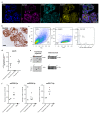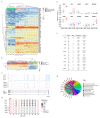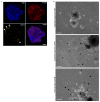Trophoblast organoids as a model for maternal-fetal interactions during human placentation
- PMID: 30487605
- PMCID: PMC7220805
- DOI: 10.1038/s41586-018-0753-3
Trophoblast organoids as a model for maternal-fetal interactions during human placentation
Abstract
The placenta is the extraembryonic organ that supports the fetus during intrauterine life. Although placental dysfunction results in major disorders of pregnancy with immediate and lifelong consequences for the mother and child, our knowledge of the human placenta is limited owing to a lack of functional experimental models1. After implantation, the trophectoderm of the blastocyst rapidly proliferates and generates the trophoblast, the unique cell type of the placenta. In vivo, proliferative villous cytotrophoblast cells differentiate into two main sub-populations: syncytiotrophoblast, the multinucleated epithelium of the villi responsible for nutrient exchange and hormone production, and extravillous trophoblast cells, which anchor the placenta to the maternal decidua and transform the maternal spiral arteries2. Here we describe the generation of long-term, genetically stable organoid cultures of trophoblast that can differentiate into both syncytiotrophoblast and extravillous trophoblast. We used human leukocyte antigen (HLA) typing to confirm that the organoids were derived from the fetus, and verified their identities against four trophoblast-specific criteria3. The cultures organize into villous-like structures, and we detected the secretion of placental-specific peptides and hormones, including human chorionic gonadotropin (hCG), growth differentiation factor 15 (GDF15) and pregnancy-specific glycoprotein (PSG) by mass spectrometry. The organoids also differentiate into HLA-G+ extravillous trophoblast cells, which vigorously invade in three-dimensional cultures. Analysis of the methylome reveals that the organoids closely resemble normal first trimester placentas. This organoid model will be transformative for studying human placental development and for investigating trophoblast interactions with the local and systemic maternal environment.
Conflict of interest statement
Figures












Comment in
-
Organoids that model the fetal placenta.Nat Methods. 2019 Feb;16(2):144. doi: 10.1038/s41592-019-0319-9. Nat Methods. 2019. PMID: 30700892 No abstract available.
References
-
- Burton GJ, Jauniaux E. What is the placenta? Am J Obs Gynecol. 2015;213:S6 e1–S6 8. - PubMed
-
- Kunath T, et al. Developmental differences in the expression of FGF receptors between human and mouse embryos. Placenta. 2014;35:1079–1088. - PubMed
-
- Paiva P, et al. Human chorionic gonadotrophin regulates FGF2 and other cytokines produced by human endometrial epithelial cells, providing a mechanism for enhancing endometrial receptivity. Hum Reprod. 2011;26:1153–1162. - PubMed
Publication types
MeSH terms
Substances
Grants and funding
- MC_UU_12012/3/MRC_/Medical Research Council/United Kingdom
- MC_UU_00014/5/MRC_/Medical Research Council/United Kingdom
- MC_UU_12012/5/MRC_/Medical Research Council/United Kingdom
- 106262/WT_/Wellcome Trust/United Kingdom
- 200841/WT_/Wellcome Trust/United Kingdom
- MR/P001092/1/MRC_/Medical Research Council/United Kingdom
- 200841/Z/16/Z/WT_/Wellcome Trust/United Kingdom
- MR/L020041/1/MRC_/Medical Research Council/United Kingdom
- MC_UU_12012/1/MRC_/Medical Research Council/United Kingdom
- MR/M009041/1/MRC_/Medical Research Council/United Kingdom
- MR/M024873/1/MRC_/Medical Research Council/United Kingdom
- 106263/WT_/Wellcome Trust/United Kingdom
- MC_UU_00014/3/MRC_/Medical Research Council/United Kingdom
LinkOut - more resources
Full Text Sources
Other Literature Sources
Research Materials

